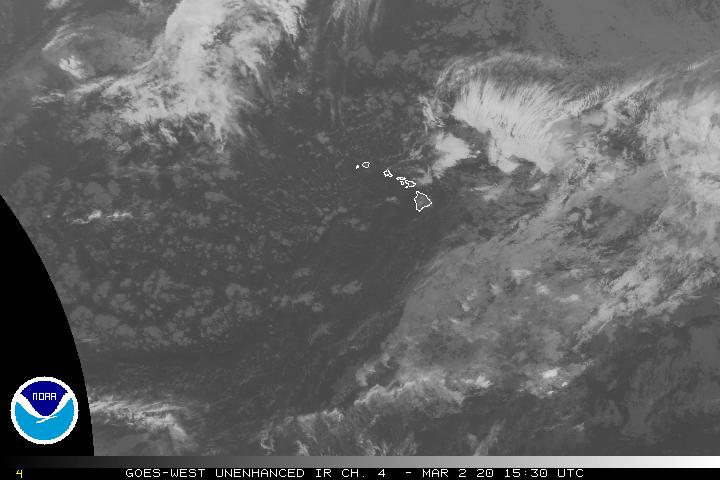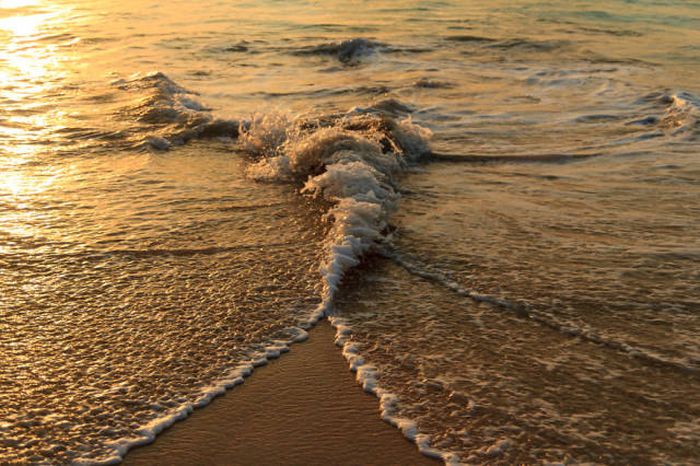Air Temperatures – The following maximum temperatures (F) were recorded across the state of Hawaii Tuesday…along with the low temperatures Tuesday:
83 – 72 Lihue, Kauai
88 – 74 Honolulu, Oahu
86 – 72 Molokai AP
90 – 74 Kahului AP, Maui – record high 92…back in 1969
87 – 75 Kailua Kona
86 – 71 Hilo AP, Hawaii
Here are the latest 24-hour precipitation totals (inches) for each of the islands…as of Tuesday evening:
1.76 Mount Waialeale, Kauai
0.13 Pupukea Road, Oahu
0.50 Puu Alii, Molokai
0.00 Lanai
0.00 Kahoolawe
0.66 Puu Kukui, Maui
0.56 Saddle Quarry, Big Island
The following numbers represent the strongest wind gusts (mph)…as of Tuesday evening:
29 Port Allen, Kauai
36 Oahu Forest NWR, Oahu
27 Molokai
25 Lanai
31 Kahoolawe
30 Kahului AP, Maui
24 Upolu AP, Big Island
Hawaii’s Mountains – Here’s a link to the live web cam on the summit of near 13,800 foot Mauna Kea on the Big Island of Hawaii. This web cam is available during the daylight hours here in the islands…and when there’s a big moon shining down during the night at times. Plus, during the nights you will be able to see stars, and the sunrise and sunset too…depending upon weather conditions.
Aloha Paragraphs

Occasional wisps of high cirrus clouds coming in from the west

Thunderstorms far offshore to the south

High level clouds temporarily gone or mostly…although more coming

Showers over the islands locally – Looping radar image
Small Craft Advisory…Maalaea Bay, Pailolo and Alenuihaha Channels
~~~ Hawaii Weather Narrative ~~~
Trade winds remaining active, calming down a little mid-week…before increasing rather significantly Friday into the weekend. Here’s the latest weather map, showing high pressure systems in the area north-northwest and northeast of Hawaii. At the same time, we see a surface trough of low pressure just northeast of Hawaii. This combination will prompt somewhat lighter winds today through Thursday. During the later part of the week, our trade winds are expected to increase a notch or two into the weekend. We may see unusual gale force winds blowing across some marine zones…with possible wind advisory conditions over some island areas.
Here’s a wind profile…of the offshore waters around the islands – with a closer view
Here’s the Hawaiian Islands Sulfate Aerosol animated graphic – showing vog forecast
There will be a few passing showers, primarily focused along the windward sides…although not exclusively. Satellite imagery shows patches of clouds upstream to the northeast for the time being, although with clouds forming over and around the mountains locally too. The models are suggesting we could see an increase in showers arriving Wednesday…bringing moisture our way into Thursday. The overlying atmosphere will become unstable enough, that some of this shower activity could become locally quite heavy, with the chance of an unusual thunderstorm flaring up here and there then. Thereafter, unusually dry conditions will arrive Friday into the holiday weekend.
Fire danger may increase over the holiday weekend across the islands. Very dry air is forecast to spread over the area from the east. Combining with the anticipated strong winds…these conditions will boost the fire danger potential. This of course could make fireworks a dangerous situation on the 4th of July holiday!
The Tropical Ocean far to our east-southeast and east: Looking at the latest models showing the eastern Pacific, it appears that there will be at least one, if not two tropical cyclones spinning up over the next 5-7 days. The first thing I see is a tropical disturbance, which may send us some tropical moisture this Sunday into the July 4th holiday. I also see a tropical cyclone forming well offshore from the Mexican coast, which will generally move towards the Hawaiian Islands. However, this is certainly not a red flag by any means, as it remains in the eastern Pacific as far as the models go out in their forecast periods. Finally, there’s a possible second tropical cyclone that forms closer to Mexico, and generally heads more northward…in the general direction of the southern tip of Baja California. In sum for here in the Hawaiian Islands, no problems on the horizon through the foreseeable future.
Marine environment details: No marine advisories are currently posted, but this will be changing over the next couple of days. High pressure will strengthen NE of the islands Thursday, and remain quite strong through the weekend. This will lead to small craft advisory conditions in many marine zones, and we will likely see unusual gale force winds in the Alenuihaha channel, and possibly a few other marine zones…where winds are most accelerated by island terrain.
Surf will remain below advisory levels along all shorelines the next several days. As trade winds strengthen late in the week and remain robust over the weekend, surf along east facing shores will increase to the point that a high surf advisory will likely be necessary. Current expectation is that surf will be largest Saturday and Sunday.

Here on Maui – Early Tuesday morning is dawning partly cloudy, with the wispy high cirrus clouds still around. These high clouds will light up a nice pink color again this morning. The air temperature was 54.6F degrees at 532am. Meanwhile, at about the same time, the Kahului airport was reporting cloudy skies, with a temperature of 75 degrees, while Hana was 72…and the summit of the Haleakala Crater was reporting 45 degrees. / At 850am, there’s some smoke in the central valley, due to an earlier sugar cane fire.
– Mid afternoon, under partly cloudy skies, with some clear areas…and cloudy ones too. It was hot down in Kahului, which peaked out at 90 degrees.
– Early evening, with a common mix of late day sunshine and clouds. There may be a few wisps of high clouds around, which could provide a little color at sunset. / Now just after sunset, clouds have increased, at least over some parts of the island, with a very light shower here in upcountry Kula. This has now quickly become more of a steady rain, and just as it gets dark…I can see that my area is enveloped in fog.
World-wide tropical cyclone activity –
>>> Atlantic Ocean: No active tropical cyclones
Tropical cyclone formation is not expected during the next 5 days
Here’s a satellite image of the Atlantic Ocean
>>> Caribbean Sea: No active tropical cyclones
Tropical cyclone formation is not expected during the next 5 days
>>> Gulf of Mexico: No active tropical cyclones
Here’s a satellite image of the Caribbean Sea…and the Gulf of Mexico
Here’s the link to the National Hurricane Center (NHC)
>>> Eastern Pacific: No active tropical cyclones
A broad area of low pressure is expected to form south of the Gulf of Tehuantepec later this week in association with a westward-moving tropical wave that is currently located south of Guatemala. Environmental conditions are forecast to be conducive for gradual development of the disturbance, and a tropical depression could form over the weekend while the system moves generally westward or west-northwestward at 10 to 15 mph, remaining well offshore of the coast of Mexico.
* Formation chance through 48 hours…low…near 0 percent
* Formation chance through 5 days…medium…60 percent
Here’s a wide satellite image that covers the entire area between Mexico, out through the central Pacific…to the International Dateline.
Here’s the link to the National Hurricane Center (NHC)
>>> Central Pacific: No active tropical cyclones
No tropical cyclones expected through the next 2-days
Here’s a link to the Central Pacific Hurricane Center (CPHC)
>>> South Pacific Ocean: No active tropical cyclones
>>> North and South Indian Oceans / Arabian Sea: No active tropical cyclones
Here’s a link to the Joint Typhoon Warning Center (JTWC)
Interesting: Household fuels exceed power plants and cars as source of smog in Beijing – Beijing and surrounding areas of China often suffer from choking smog. The Chinese government has made commitments to improving air quality and has achieved notable results in reducing emissions from the power and transportation sectors. However, new research indicates that the government could achieve dramatic air quality improvements with more attention on an overlooked source of outdoor pollution — residential cooking and heating.
“Coal and other dirty solid fuels are frequently used in homes for cooking and heating,” said Denise Mauzerall, a professor of civil and environmental engineering and public and international affairs at Princeton University. “Because these emissions are essentially uncontrolled they emit a disproportionately large amount of air pollutants which contribute substantially to smog in Beijing and surrounding regions.”
Households account for about 18 percent of total energy use in the Beijing region but produce 50 percent of black carbon emissions and 69 percent of organic carbon emissions, according to a research team from institutions including Princeton, the University of California Berkeley, Peking University and Tsinghua University. In the Beijing area, households contribute more pollutants in the form of small soot particles (which are particularly hazardous to human health) than the transportation sector and power plants combined; in the winter heating season, households also contribute more small particles than do industrial sources.
The researchers said the high levels of air pollutant emissions are due to the use of coal and other dirty fuels in small stoves and heaters that lack the pollution controls in place in power plants, vehicles and at some factories.
The “use of solid fuels (coal and biomass) for heating and cooking in households contributes directly to exposures in and around residences and is a major source of ill health in China,” the researchers wrote in an article published online on June 27, 2016 in the Proceedings of the National Academy of Sciences. The researchers said illness caused by air pollution was a leading cause of premature death in China ranking between high blood pressure and smoking as risk factors.
The researchers used a sophisticated air pollution model to evaluate the benefits of reducing residential emissions on air pollution levels in Beijing and the surrounding region in the winter of 2010. The region in the study, which has a population of 104 million people, and frequently has air pollution levels more than six times higher than what the World Health Organization considers a safe limit, included the cities of Beijing and the surrounding Tianjin and Hebei provinces. The researchers ran computer model simulations in which they removed a varying amount of residential emissions in both Beijing alone as well as the entire Beijing-Tianjin-Hebei (BTH) region and found that reducing residential emissions resulted in corresponding drops in outdoor pollution levels.
“The residential sector has been relatively overlooked in ambient air pollution control strategies,” Mauzerall said. “Our analysis indicates that air quality in the Beijing region would substantially benefit from reducing residential sector emissions from within Beijing and from surrounding provinces. Air pollution levels in Beijing would greatly benefit from a regional strategy to reduce emissions from dirty cook stoves.”
The researchers concluded from their study that eliminating household emissions alone would reduce levels of small particulate pollution in the air over Beijing in winter by about 22 percent, but that eliminating household emissions in all three provinces that include Beijing would nearly double the reduction in particulate levels in the city itself.
“Reducing residential emissions from the entire region, including the surrounding rural areas, has the potential to greatly improve air quality within Beijing and its suburbs,” Mauzerall said. The researchers said the government can take additional steps both in the near term and the future to reduce emissions. Natural gas, liquid petroleum gas, cleaner solid-fuel stoves and electricity can presently reduce emissions. In the long-term electricity from renewable energy sources would virtually eliminate the emissions of both air pollutants and the greenhouse gases that contribute to climate change.












 Email Glenn James:
Email Glenn James: